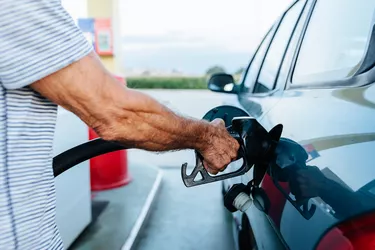
You're on vacation, cruising America's great highways, the happiest you've been in months. Then it happens. You pull in to a remote gas station to fill up, swipe your debit card, and somehow the transaction is declined.
Scrounging through your wallet in disbelief, you find only lint and expired coupons. Now you're stranded with no money and no gas. How did it come to this? There are a variety of common reasons.
Video of the Day
Video of the Day
Read More: How to Use Credit/Debit Cards at the Gas Pump
You Have Insufficient Funds
Debit cards draw funds from a linked bank account and they're only good for the money that's in the account. The card reader creates an electronic transaction with your financial institution asking approval for the purchase. Your institution will decline the request if your account is not in good standing or if there aren't enough funds to complete the transaction.
Card Transaction Hold
Most gas stations require you to pay before you pump your gas, so that you can't take the gas and then drive off without paying. The problem is that the gas station doesn't know how much gas you're actually going to pump until you've pumped it. They get around this by conducting two transactions.
The first is when you actually swipe your card. The gas station computer will ask your bank's computer if it will set aside a predetermined amount of money in your checking account. This practice is called a "block" or a "hold," and the value of funds held can range from $1 to $100 depending on the gas station's policy.
The more money that the gas station asks your bank to set aside, the better it can protect itself from customer fraud. In the meantime, that amount of money would be unavailable for up to several days, until the bank processes the second transaction—the one detailing your actual gas purchase.
This practice is a burden on many legitimate customers. Suppose you have $50 in your account, and you plan to buy $40 in gas. Unbeknownst to you, however, the gas station automatically asks your bank for $100 to be set aside.
Technically you have enough money for the gas you plan to buy, but you don't have enough to cover the automatic hold on your funds in the amount of $100. Therefore, the bank declines the transaction. You can sometimes get around this by going inside the station and paying at the counter.
Read More: Why Has My Credit or Debit Card Been Declined?
Magnetic Strip Decay
Over time, the magnetic strip which stores your debit card account information on the card itself will deteriorate. When this happens, the card reader at gas stations will sometimes be unable to verify your card, and thus will decline the transaction. This is one reason that banks will send you a replacement debit card every few years.
You can slow this process in the meantime by storing your card safely in your wallet and keeping it away from magnetized substances such as pocket magnets or pocket hand warmers. If you're having problems with your debit card at more than just gas stations, magnetic strip decay is a likely candidate.
Fraud Freeze by Your Bank
Banks keep track of where your debit card is being used. If your bank's fraud detection system detects activity across large geographical distances over a short period of time, it may think that someone has stolen your account information and may freeze the card. This is a risk when you travel. If it happens, you would not be able to use your debit card anywhere. Call your bank.
Entered the Wrong PIN
When you use your debit card as a debit card, you usually have to enter your personal identification number. This secret code helps protect your card from abuse if it falls into somebody else's hands. If you're entering the wrong PIN, your transaction will be declined. People often input the wrong PIN by mistake, and since the characters appear as asterisks you won't know it until you've submitted the code. If your card gets declined, try it again and pay close attention to make sure you enter the correct PIN.